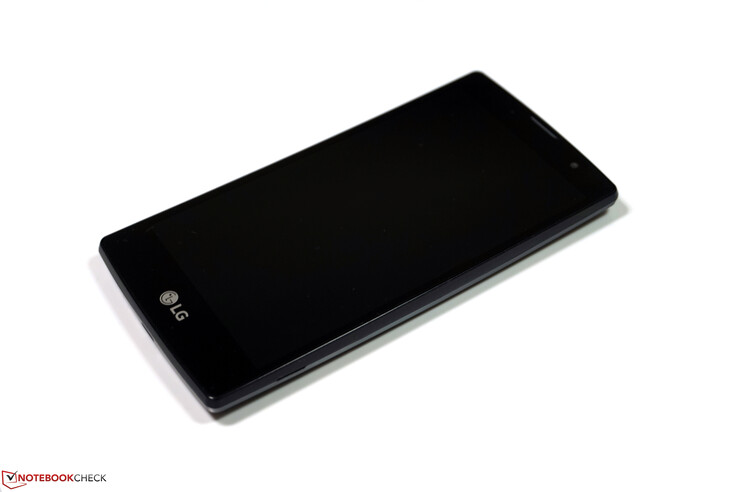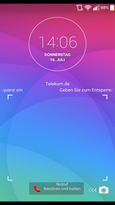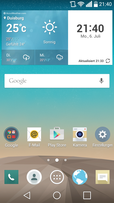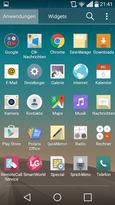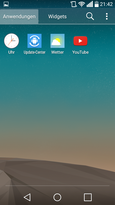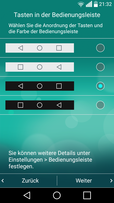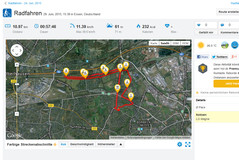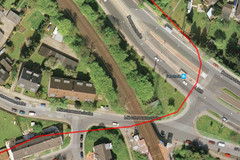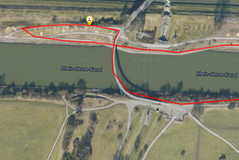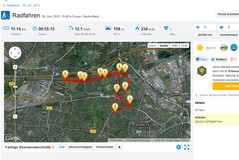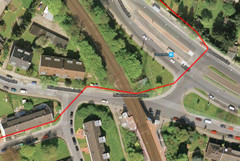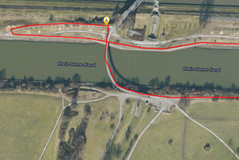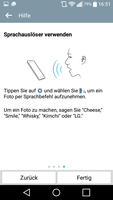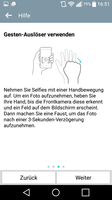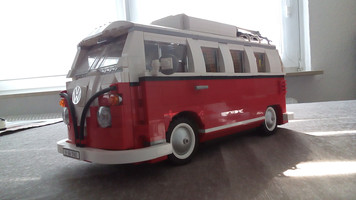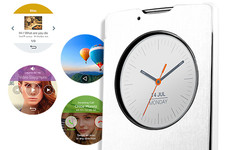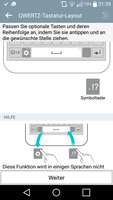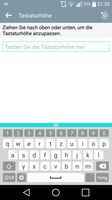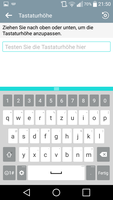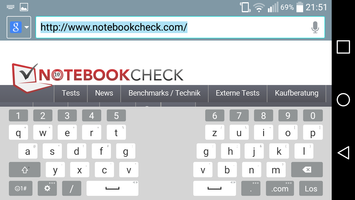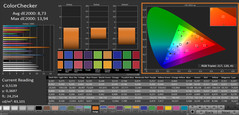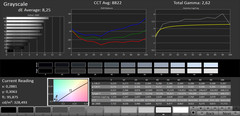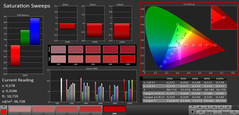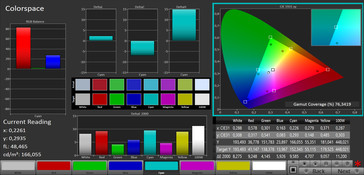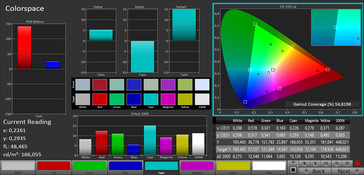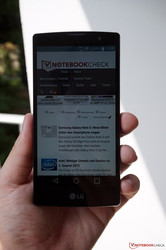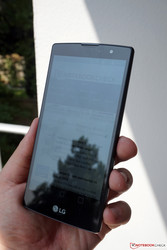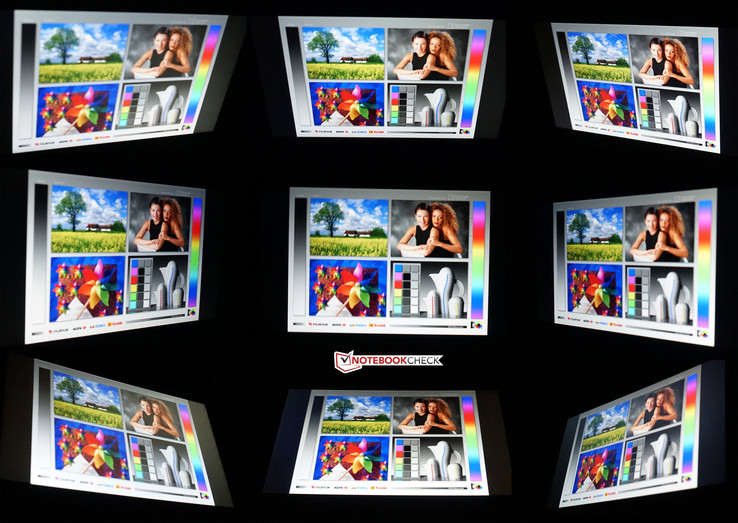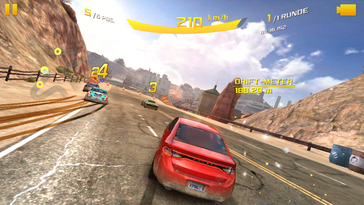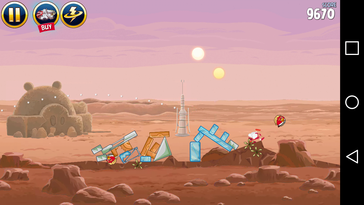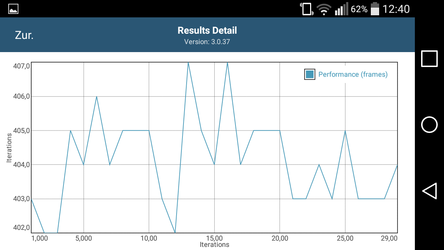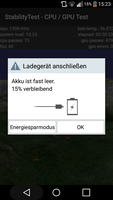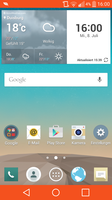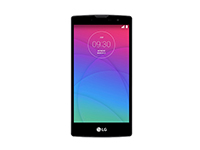LG Magna Smartphone Review

For the original German review, see here.
The Magna is one of the new mainstream smartphones that LG currently launches. There are four new series in total (we reported) and the Magna with its 5-inch display as well as the quad-core processor is the biggest and also fastest device of the bunch. The design of the rounded case is heavily inspired by the high-end products from the G-series and the new smartphones get some of the features that were previously reserved for the top models. LG also follows the current selfie trend and equips the Magna with a 5 MP camera and several functions that are supposed to make selfies easier.
The Magna is available for around 200 Euros (~$222), which means it faces a lot of rivals. Besides other mainstream smartphones, this price range also includes some older high-end products that are much cheaper by now. The biggest competitors are the Acer Liquid Jade Z, the Motorola Moto G2 as well as the Nokia Lumia 735. There are also other contenders like the Samsung Galaxy A3, the ZTE Blade S6 or the Amazon Fire Phone, whose price has been reduced recently.
Case
According to LG, the Magna uses a slightly curved design, which is supposed to provide very good ergonomics. We can confirm that, but the device is also the thickest smartphone in our comparison at 10.2 mm (~0.4 in) because of the curved design. Overall, the design is very similar to the current top model LG G4. Instead of a back cover made of leather, however, the mainstream smartphone only gets a plastic cover that looks like brushed metal that leaves a somewhat cheap tactile impression and does not appear to be very sophisticated. Fingerprints are no problem for the matte back, but we could already see some small scratches at the back, even though we were very careful. The entire back cover can be removed and grants access to the battery as well as the combined slot for the microSD and Micro-SIM card. Besides the black review version, LG also offers a white version of the Magna.
The stability of the device is very good and neither pressure nor twisting attempts can create picture distortions or creaking. Similar to the G4, there are just three hardware buttons on the chassis, which are all located at the back underneath the camera. Besides the central power button, you also get a volume rocker. All buttons are well integrated, but the power button does produce a pretty loud noise when you push it.
Connectivity
LG offers two versions of the Magna, which differ in terms of the processor and therefore also the supported wireless standards. The 3G version uses a MediaTek MT6582 quad-core SoC (1.3 GHz), while the LTE version (LTE Cat. 4) is equipped with a Snapdragon 410 SoC (MSM 8916) clocked at 1.2 GHz per core. Otherwise, the two models are identical. Besides 1 GB memory, you get 8 GB internal storage, but you can only use around 3.8 GB for your own files and apps. It is, however, possible to expand the storage by up to 32 GB via microSD card and the majority of apps can be transferred to the card, but they have to be installed on the internal storage first. There are just two ports on the device: One Micro-USB 2.0 port for charging and data at the bottom as well as a 3.5 mm stereo jack at the top.
Communication with other devices is possible via Bluetooth 4.0, MHL as well as Wi-Fi Direct, but unfortunately, the smartphone does not support NFC, Miracast or USB-OTG.
Software
The operating system of the LG Magna is Android 5.0.1 Lollipop in combination with LG’s own user interface LG UX 4.0. Besides the familiar apps from Google, the manufacturer also installs some additional tools including the familiar QuickMemo+. It can be used to make comments or notes directly on the screen and then save the results. Furthermore, there is also LG’s own app store LG SmartWorld, Polaris Office and RemoteCall Service for remote support. It is also no problem to delete these additional apps. The Android buttons are software buttons and therefore use some space on the display, which means you can only use 1184x720 from the actual 1280x720 pixels. However, many apps can fade them out, so this is not a big deal in practice.
Another special feature of the LG Magna is the so-called "Knock Code". Besides the usual unlock methods like a PIN, a pattern or a password, the smartphone can also be unlocked with a predefined knocking pattern. There are four squares, which can be tapped from three up to six times. The advantage of this method is that you can also activate the smartphone when it is lying on a table, for example, without using the power button at the back. The feature worked very well in the review and it is a convenient alternative to the usual methods.
Above the display is a red status light. You can configure the behavior of it in the settings (e.g. during calls, messages, mails, during charge and so on).
Communication & GPS
Our review unit only supports UMTS with maximum transfer rates of up to 21 Mbps (downstream) and 5.76 Mbps (upstream), but not the fast LTE standard. Dual-band UMTS (900 and 2,100 MHz) as well as quad-band GSM (850/900/1,800/1,900 MHz) is not very generous, either. The signal quality in the metropolitan T-Mobile network was a bit problematic because 3G was not always available.
The situation is not much better for the Wi-Fi module since the fast ac standard is not supported by the LG Magna. The module only supports the 802.11 standards b/g/n in 2.4 GHz networks. The signal quality was average in the individual setup of the author (access point: Asus RT-AC56U).
The location of the LG Magna can only be determined by the GPS satellite network; GLONASS or Beidou are not supported. The app GPS Test did show some satellites indoors, but the signal quality was not sufficient to get a position. The first satellite fix takes about 40 seconds outdoors with an accuracy of 10 meters (~33 feet).
We also wanted to check the performance in a practical scenario and took the LG Magna on a bicycle ride and compared it with the professional Garmin GPSMAP64s navigation device. The smartphone does a pretty good job. The overall track length is around 160 meters (~175 yards) shorter compared to the professional device and it does not locate the position as often, which results in some shortcuts, but the deviations are very low in the difficult bridge segment in return. There should not be any problems when you use it for the navigation in the car.
Telephone & Voice Quality
The phone app does not reveal any surprises and there are no special features, either. You can see the large numbers pad where you can enter the phone numbers when you launch the app. At the top are the usual tabs for call history, contacts, favorites as well as groups. The handling should not be a problem for anybody.
The quality of the calls is best described as unremarkable and there were no dropouts or annoying background noises during the calls. Voices were slightly distorted at both ends, but this did not affect the understandability.
The hands-free feature does not leave a good impression. Voices distort quickly and tend to roar, especially at higher volumes. Another issue is the position of the speaker at the back, because the sound will be muffled as soon as you put the smartphone down. The quality was okay on our side of the call with the provided headset; our voice was recorded slightly distorted, but it was still easy to understand.
Cameras & Multimedia
LG follows the current selfie trend and equips the LG Magna with a 5 MP wide-angle front camera. This is supposed to ensure that a couple of people can get into the picture. LG also implements some features that are supposed to improve the process of taking pictures. This includes a gesture control as well as a voice control. The smartphone will recognize when you hold your hand in front of the camera. As soon as you make a fist, the smartphone starts a 3-second countdown and then takes the picture. This worked well in our review and mainly improves the use of a selfie stick. The voice control recognizes one of five words: "Cheese", "Smile", "Whisky", "Kimchi" or "LG". It was a matter of luck if the smartphone recognized it during the test; we had the biggest success with the typical "Cheese".
We expected more from the quality of the front camera. The pictures (2560x1920 pixels) quickly suffer from picture noise and details look blurry. It is even worse when the lighting conditions are not perfect. It is possible to use the display as a kind of flash in the dark. The preview image is made smaller and the rest of the screen glows white, which means you have at least some light. The quality is better than without an additional light, but you cannot compare it with a real flash.
At the back is an 8 MP camera that is supported by an LED flash. The maximum resolution is 3264x2448 pixels (4:3), but you can only use 6 MP (3264x1840 pixels) for 16:9 pictures. The camera app does not offer many adjustments, but is easy to use in return. Besides the target destination (internal or SD card), you can show a grid, set a timer, activate the voice control and select the resolution for pictures as well as videos. Other settings are not available.
The quality of the pictures is okay, despite the comparatively low resolution. Compared to high-end smartphones and the reference camera, you can see the lower light sensitivity and colors appear paler. Details are quickly blurry when you zoom in, which is a result of the low resolution. The results under bad lighting conditions are pretty good for a mainstream smartphone. The picture noise is more noticeable compared to the comparison devices, but you can easily see all the details. All in all, not an overwhelming performance, but the quality is easily sufficient for snapshots.
Videos (.mp4 file) can be recorded in Full HD at 30 fps. Unfortunately, the frame rate is locked at 30 fps even with the lower HD resolution (1280x720). A handy feature is the pause button during recordings, which means you do not always have to start a new video. The quality of the recordings is convenient when the lighting is good and fast movements are no problem for the sensor, either. However, you can clearly notice picture noise when it gets darker.
Accessories
The Magna is shipped with a battery, a modular power adaptor, a USB data cable, a headset as well as a quick-start guide.
LG does not offer any special accessories for the Magna, but already advertises the QuickCircle case in the functions. We already know this case from the LG G3. At the front is a circled opening that can be used to display different information (time, calls etc.).
Warranty
The warranty period is 24 months, but the battery is only covered for 6 months.
Input Devices & Handling
The virtual keyboard is very easy to use and LG already implemented additional features. This includes swype inputs (have to be activated in the settings), word predictions, voice inputs as well as auto corrections. There is also an additional row with numbers above the letters and you can select different special characters via the point key, which means you do not have to switch the view very often.
We also like the fact that you can personalize the keyboard. It is, for example, possible to change the layout of the lower row and adjust the height of the whole keyboard to a certain extent. There is also a one-handed mode, but it is tricky to reach in the settings (available for left- and right-handers), so you cannot change it quickly during typing. The keyboard can also be split in landscape mode, which improves the typing with the thumbs.
The gliding capabilities of the display are good and there is no noticeable gap between the glass surface and the display itself thanks to the In-Cell technology (more on that in the Display section), which improves the handling. Overall, the latter is very smooth and there are just minimal delays (see video). The automatic display rotation works reliably and happens within one second.
Display
LG equips the Magna with a 5-inch HD IPS display. The native resolution is 1280x720 pixels, which results in a good pixel density of 296 PPI. Fonts are very sharp and you cannot see individual pixels at a normal viewing distance. The brightness can be adjusted automatically by the light sensor, which works reliably.
LG uses In-Cell technology for the display, where the touch sensors are directly integrated into the LCD. This means there is no annoying gap between the glass and the display itself. The Magna does not have to hide behind its rivals, because none of them has a higher resolution and the subjective impression of the display is good as well.
Our measurements show an average brightness of 438 cd/m² and a decent brightness distribution at 89 percent. Only the former high-end device Amazon Fire Phone is even brighter, all the other rivals are sometimes clearly behind (see table). The black value often suffers from such a high brightness, but we can still measure a good value of 0.35 cd/m², which results in an excellent contrast ratio of 1263:1. Black contents are therefore not completely dark and have a slight gray hue, but the colors are generally very vivid.
The results so far are very good for a mainstream smartphone, but there has to be a catch somewhere?
| |||||||||||||||||||||||||
Brightness Distribution: 89 %
Center on Battery: 442 cd/m²
Contrast: 1263:1 (Black: 0.35 cd/m²)
ΔE ColorChecker Calman: 8.73 | ∀{0.5-29.43 Ø4.77}
ΔE Greyscale Calman: 8.25 | ∀{0.09-98 Ø5}
Gamma: 2.62
CCT: 8822 K
| LG Magna Mali-400 MP2, MT6582, 8 GB eMMC Flash | Acer Liquid Jade Z Mali-T760 MP2, MT6732, 16 GB eMMC Flash | Motorola Moto G 2. Gen XT1068 Adreno 305, 400 MSM8226, 8 GB SSD | Nokia Lumia 735 Adreno 305, 400 MSM8926, 8 GB eMMC Flash | Amazon Fire Phone Adreno 330, 800 MSM8974, 32 GB eMMC Flash | Samsung Galaxy A3 Adreno 306, 410 MSM8916, 16 GB eMMC Flash | ZTE Blade S6 Adreno 405, 615 MSM8939, 16 GB eMMC Flash | |
|---|---|---|---|---|---|---|---|
| Screen | -5% | 3% | 11% | 30% | 28% | -7% | |
| Brightness middle (cd/m²) | 442 | 343 -22% | 349 -21% | 291 -34% | 587 33% | 434 -2% | 386 -13% |
| Brightness (cd/m²) | 438 | 340 -22% | 348 -21% | 293 -33% | 565 29% | 433 -1% | 377 -14% |
| Brightness Distribution (%) | 89 | 93 4% | 96 8% | 93 4% | 93 4% | 96 8% | 90 1% |
| Black Level * (cd/m²) | 0.35 | 0.39 -11% | 0.4 -14% | 0.42 -20% | 0.44 -26% | ||
| Contrast (:1) | 1263 | 879 -30% | 873 -31% | 1398 11% | 877 -31% | ||
| Colorchecker dE 2000 * | 8.73 | 5.59 36% | 3.74 57% | 4.04 54% | 1.45 83% | 2.98 66% | 7.12 18% |
| Greyscale dE 2000 * | 8.25 | 7.25 12% | 4.52 45% | 2.87 65% | 2.59 69% | 2.68 68% | 6.7 19% |
| Gamma | 2.62 84% | 2.41 91% | 2.63 84% | 2.49 88% | 2.57 86% | 2.44 90% | 1.98 111% |
| CCT | 8822 74% | 7361 88% | 7336 89% | 6432 101% | 6520 100% | 6603 98% | 7784 84% |
* ... smaller is better
Our measurements with the X-Rite i1Pro2 colorimeter and the professional software CalMAN quickly show the drawbacks of the panel. The average deviations of the colors and the grayscale compared to the sRGB reference color space are very high at 8.73 and 8.25, respectively, while the target value is less than 3. All the rivals are much better and the LG Magna is in the last spot. This means the smartphone is not the perfect solution if you want accurate colors, but you get rich colors in practice in return, which might be appealing for some users. All the colors show deviations, so there is no visible color cast.
Performance
Our review unit uses a MediaTek MT6582 SoC (32-bit) with four cores running at 1.3 GHz. It is an inexpensive processor usually used for entry-level devices. The SoC also includes the ARM Mali-400 MP2 GPU with a clock of 500 MHz. This package is supported by 1 GB RAM.
We already mentioned that there is also an LTE version of the LG Magna besides our review unit. This does not only differ by the fast mobile Internet connection, but also the SoC. The Qualcomm Snapdragon 410 (64-bit) is a bit more powerful and also uses the faster Adreno 306 GPU. One indicator for the performance difference between the two versions is the Samsung Galaxy A3, which uses the Snapdragon 410 clocked at 1.2 GHz as well.
The LG Magna has a pretty tough time against the fast rivals in the benchmarks. The processor is ahead of the Moto G2 (Snapdragon 400) in Geekbench 3, but falls behind all the other devices. The situation is even worse for the GPU, because the Mali-400 MP4 is always in the last spot.
The internal storage leaves a better impression. Especially the transfer rates during reading are decent among the comparison, only the values for the writing operations are lower due to the limited storage capacity of just 8 GB.
| Geekbench 3 | |
| 32 Bit Multi-Core Score (sort by value) | |
| LG Magna | |
| Acer Liquid Jade Z | |
| Motorola Moto G 2. Gen XT1068 | |
| Amazon Fire Phone | |
| Samsung Galaxy A3 | |
| 32 Bit Single-Core Score (sort by value) | |
| LG Magna | |
| Acer Liquid Jade Z | |
| Motorola Moto G 2. Gen XT1068 | |
| Amazon Fire Phone | |
| Samsung Galaxy A3 | |
| 3DMark | |
| 1280x720 offscreen Ice Storm Unlimited Score (sort by value) | |
| LG Magna | |
| Acer Liquid Jade Z | |
| Motorola Moto G 2. Gen XT1068 | |
| Amazon Fire Phone | |
| Samsung Galaxy A3 | |
| ZTE Blade S6 | |
| 1280x720 offscreen Ice Storm Unlimited Graphics Score (sort by value) | |
| LG Magna | |
| Acer Liquid Jade Z | |
| Motorola Moto G 2. Gen XT1068 | |
| Amazon Fire Phone | |
| Samsung Galaxy A3 | |
| ZTE Blade S6 | |
| 1280x720 offscreen Ice Storm Unlimited Physics (sort by value) | |
| LG Magna | |
| Acer Liquid Jade Z | |
| Motorola Moto G 2. Gen XT1068 | |
| Amazon Fire Phone | |
| Samsung Galaxy A3 | |
| ZTE Blade S6 | |
| PCMark for Android - Work performance score (sort by value) | |
| LG Magna | |
| Acer Liquid Jade Z | |
| Amazon Fire Phone | |
| ZTE Blade S6 | |
| AnTuTu v5 - Total Score (sort by value) | |
| LG Magna | |
| Acer Liquid Jade Z | |
| Motorola Moto G 2. Gen XT1068 | |
| Amazon Fire Phone | |
| ZTE Blade S6 | |
| GFXBench (DX / GLBenchmark) 2.7 | |
| T-Rex Onscreen (sort by value) | |
| LG Magna | |
| Acer Liquid Jade Z | |
| Motorola Moto G 2. Gen XT1068 | |
| Nokia Lumia 735 | |
| Samsung Galaxy A3 | |
| ZTE Blade S6 | |
| 1920x1080 T-Rex Offscreen (sort by value) | |
| LG Magna | |
| Acer Liquid Jade Z | |
| Motorola Moto G 2. Gen XT1068 | |
| Nokia Lumia 735 | |
| Samsung Galaxy A3 | |
| ZTE Blade S6 | |
We performed the browser tests with the preloaded LG browser, which is based on Chrome 38. The LG Magna is always at the bottom of the ranking in the benchmarks, sometimes with a pretty big distance. Still, the subjective impression does not cause any criticism. Websites are loaded quickly and the navigation on more complex sites is no problem, either. This means you will not notice any restrictions in practice when you do not have a direct comparison.
| Sunspider - 1.0 Total Score (sort by value) | |
| LG Magna | |
| Acer Liquid Jade Z | |
| Motorola Moto G 2. Gen XT1068 | |
| Nokia Lumia 735 | |
| Amazon Fire Phone | |
| Samsung Galaxy A3 | |
| ZTE Blade S6 | |
| Octane V2 - Total Score (sort by value) | |
| LG Magna | |
| Acer Liquid Jade Z | |
| Motorola Moto G 2. Gen XT1068 | |
| Nokia Lumia 735 | |
| Amazon Fire Phone | |
| Samsung Galaxy A3 | |
| ZTE Blade S6 | |
| Mozilla Kraken 1.1 - Total (sort by value) | |
| LG Magna | |
| Acer Liquid Jade Z | |
| Nokia Lumia 735 | |
| Amazon Fire Phone | |
| Samsung Galaxy A3 | |
| ZTE Blade S6 | |
| Google V8 Ver. 7 - Google V8 Ver. 7 Score (sort by value) | |
| LG Magna | |
| Nokia Lumia 735 | |
| Amazon Fire Phone | |
| Samsung Galaxy A3 | |
| ZTE Blade S6 | |
| WebXPRT 2015 - Overall (sort by value) | |
| LG Magna | |
| Amazon Fire Phone | |
* ... smaller is better
Games
The Mali-400 MP2 GPU from ARM runs at 500 MHz and the chip has problems to keep up with the newer rivals. It only supports OpenGL ES 2.0, which is why we could not perform all of our benchmarks. The limited performance is also noticeable when you play games, because more demanding titles require reduced details. A good example is the racing game Asphalt 8, which only runs smoothly at low settings. Simpler titles like Angry Birds, however, are no problem for the LG Magna. The gaming experience also benefits from the precise touchscreen and the well-working sensors.
Emissions
Temperature
The temperature development of the LG Magna is not critical by any means. The device only gets lukewarm with normal tasks and even the temperatures under load are no issue reaching only 37.5 °C (99.5 °F). We check the performance under sustained load with the GFXBench 3.0 Battery Test, which repeats the T-Rex test thirty times and logs the performance as well as the temperature. We can see that there are no restrictions, and the frame rate only varies by a couple of pictures over the course of the test.
(+) The maximum temperature on the upper side is 37.5 °C / 100 F, compared to the average of 35.2 °C / 95 F, ranging from 21.9 to 247 °C for the class Smartphone.
(+) The bottom heats up to a maximum of 36.9 °C / 98 F, compared to the average of 34 °C / 93 F
(+) In idle usage, the average temperature for the upper side is 31.1 °C / 88 F, compared to the device average of 32.9 °C / 91 F.
Speakers
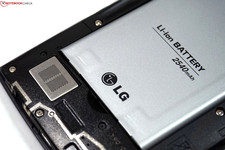
The mono speaker is at the lower rear of the LG Magna. LG proudly advertises the 1-Watt speaker for excellent sound results. We were, however, not blown away by the sound, because it is very focused on the high tones, but bass and medium tones are hardly present at all. The maximum volume is comparatively high, but there will be distortions and the sound starts to rattle when the volume setting is higher than 80 percent. The position of the speaker is another problem since the result will be heavily muffled when the device is lying on a hard, or even worse, a soft surface.
The quality is much better via the 3.5 mm stereo jack, but the maximum volume is not very high. You will quickly reach the limit when the music or movie is quieter, which also means the smartphone does not work well with high-impedance headphones. By the way, you should avoid the provided headset for music playback.
It was no problem to connect the smartphone with an external Bluetooth speaker (Denon Envaya Mini), and there were no delays during the playback, either. A bit annoying was the limited range, because there were already dropouts at a distance of 4 meters (~13 feet/direct sight).
Energy Management
Power Consumption
The power consumption leaves mixed impressions. The values in the idle measurements are comparatively high, only the ZTE Blade S6 consumes even more power. The Amazon Fire Phone also has a higher consumption, which is a result of the brighter display as well as the four sensors at the front.
Our measurements show that the situation changes under load, where the LG Magna is more frugal than many of the comparison devices. Only the Samsung Galaxy A3 consumes less. Good: The Magna does not consume any power when it is turned off and just 0.1 Watts during standby.
The 4.25-Watt power adaptor (5V, 0.85A) is powerful enough for the maximum consumption of 2.9 Watts, but takes quite a while to charge the smartphone, which we will see in the next section.
| LG Magna Mali-400 MP2, MT6582, 8 GB eMMC Flash | Acer Liquid Jade Z Mali-T760 MP2, MT6732, 16 GB eMMC Flash | Motorola Moto G 2. Gen XT1068 Adreno 305, 400 MSM8226, 8 GB SSD | Nokia Lumia 735 Adreno 305, 400 MSM8926, 8 GB eMMC Flash | Amazon Fire Phone Adreno 330, 800 MSM8974, 32 GB eMMC Flash | Samsung Galaxy A3 Adreno 306, 410 MSM8916, 16 GB eMMC Flash | ZTE Blade S6 Adreno 405, 615 MSM8939, 16 GB eMMC Flash | |
|---|---|---|---|---|---|---|---|
| Power Consumption | 13% | 30% | 12% | -42% | 40% | -64% | |
| Idle Minimum * (Watt) | 1.6 | 0.8 50% | 0.6 62% | 0.6 62% | 1.3 19% | 0.6 62% | 1.6 -0% |
| Idle Average * (Watt) | 1.9 | 1.2 37% | 1 47% | 1.4 26% | 1.8 5% | 0.9 53% | 2.5 -32% |
| Idle Maximum * (Watt) | 2 | 1.5 25% | 1.2 40% | 1.9 5% | 2.1 -5% | 1.1 45% | 2.8 -40% |
| Load Average * (Watt) | 2.4 | 3 -25% | 1.9 21% | 2.6 -8% | 3.7 -54% | 1.8 25% | 5.5 -129% |
| Load Maximum * (Watt) | 2.9 | 3.6 -24% | 3.5 -21% | 3.6 -24% | 8 -176% | 2.4 17% | 6.3 -117% |
* ... smaller is better
| Off / Standby | |
| Idle | |
| Load |
|
Key:
min: | |
Battery Runtime
LG equips the Magna with a replaceable 9.7-Wh lithium-ion polymer battery (2540 mAh, 3.8 V). The smartphone can benefit from the comparatively low consumption under load and manages 4.5 hours, which easily surpasses the rivals. Only the Nokia Lumia 735 with its AMOLED display (lower brightness, but higher contrast in return) lasts one hour longer. We simulate the maximum load with the app Stability Test, the maximum brightness as well as activated communication modules.
More interesting are the tests with an adjusted brightness at 150 cd/m² (60 percent). Our Wi-Fi test simulates web browsing with an automated script. Some of the comparison devices were still tested with the old Wi-Fi test, so the results are not directly comparable. Almost eight hours are not a bad result for the LG Magna, but the competition has more stamina. The playback of a movie (Big Buck Bunny 1080p) is possible for around 8.5 hours. The rivals once again have an advantage of at least one hour, only the ZTE Blade S6 is slightly beaten in both scenarios.
LG also implemented an energy-saving mode, which can be automatically activated at certain capacities (15 percent remaining, for example). The feature is clearly noticed by the red bars at the top and bottom of the screen. Apart from a reduced display brightness, however, we could not determine any restrictions. Other manufacturers are much more aggressive.
Charging the smartphone requires patience, because it will take more than 3.5 hours before the battery is fully charged when the smartphone is turned on.
| LG Magna Mali-400 MP2, MT6582, 8 GB eMMC Flash | Acer Liquid Jade Z Mali-T760 MP2, MT6732, 16 GB eMMC Flash | Motorola Moto G 2. Gen XT1068 Adreno 305, 400 MSM8226, 8 GB SSD | Nokia Lumia 735 Adreno 305, 400 MSM8926, 8 GB eMMC Flash | Amazon Fire Phone Adreno 330, 800 MSM8974, 32 GB eMMC Flash | Samsung Galaxy A3 Adreno 306, 410 MSM8916, 16 GB eMMC Flash | ZTE Blade S6 Adreno 405, 615 MSM8939, 16 GB eMMC Flash | |
|---|---|---|---|---|---|---|---|
| Battery runtime | -12% | 28% | 15% | -2% | 6% | -16% | |
| Reader / Idle (h) | 16.9 | 19.9 18% | 18.5 9% | 17.8 5% | 18 7% | 15.4 -9% | |
| H.264 (h) | 8.6 | 15.7 83% | 10.7 24% | 10.1 17% | 10 16% | 8.3 -3% | |
| WiFi v1.3 (h) | 7.8 | 8.7 12% | 10.1 29% | 7.2 -8% | |||
| Load (h) | 4.5 | 2.9 -36% | 3.7 -18% | 5 11% | 1.8 -60% | 4.3 -4% | 2.5 -44% |
| WiFi (h) | 15.1 | 12.7 | 9.5 |
Pros
Cons
Verdict
The LG Magna tries to establish some features and functions of the premium smartphones in the mainstream segment. The curved design of the Magna is based on the bigger sibling LG G4 and both the stability as well as the build quality can convince us, only the plastic cover, which is susceptible to scratches and looks cheap, affects the good impression a bit. We also liked some features like the gesture control for the camera. Android 5.0.1 Lollipop is up to date and can be operated smoothly. Other positive aspects are the bright display as well as the replaceable battery and the storage expansion via microSD card.
The two cameras cannot fully meet our expectations; especially the 5 MP sensor at the front is a bit disappointing. Normal webcams are easily beaten by the module, but the pictures, unfortunately, suffer from picture noise and blurry details, even under good lighting conditions. The quality of the 8 MP sensor at the back is sufficient for snapshots.
The LG Magna is a mainstream smartphone with many features from the high-end segment, but the rivals often have an advantage in respect of the performance.
One drawback of our review unit is the mediocre performance, because the rivals often have a clear advantage in the benchmarks. The graphics solution in particular is outdated by now, which is already noticeable when you play games. The competitors also have an advantage in respect of the practical runtimes.
All in all, the LG Magna leaves a decent impression. However, our review unit does not support LTE and falls a bit behind in terms of performance, so a closer look at the rivals is not a bad idea.
LG Magna
- 07/21/2015 v4 (old)
Andreas Osthoff




